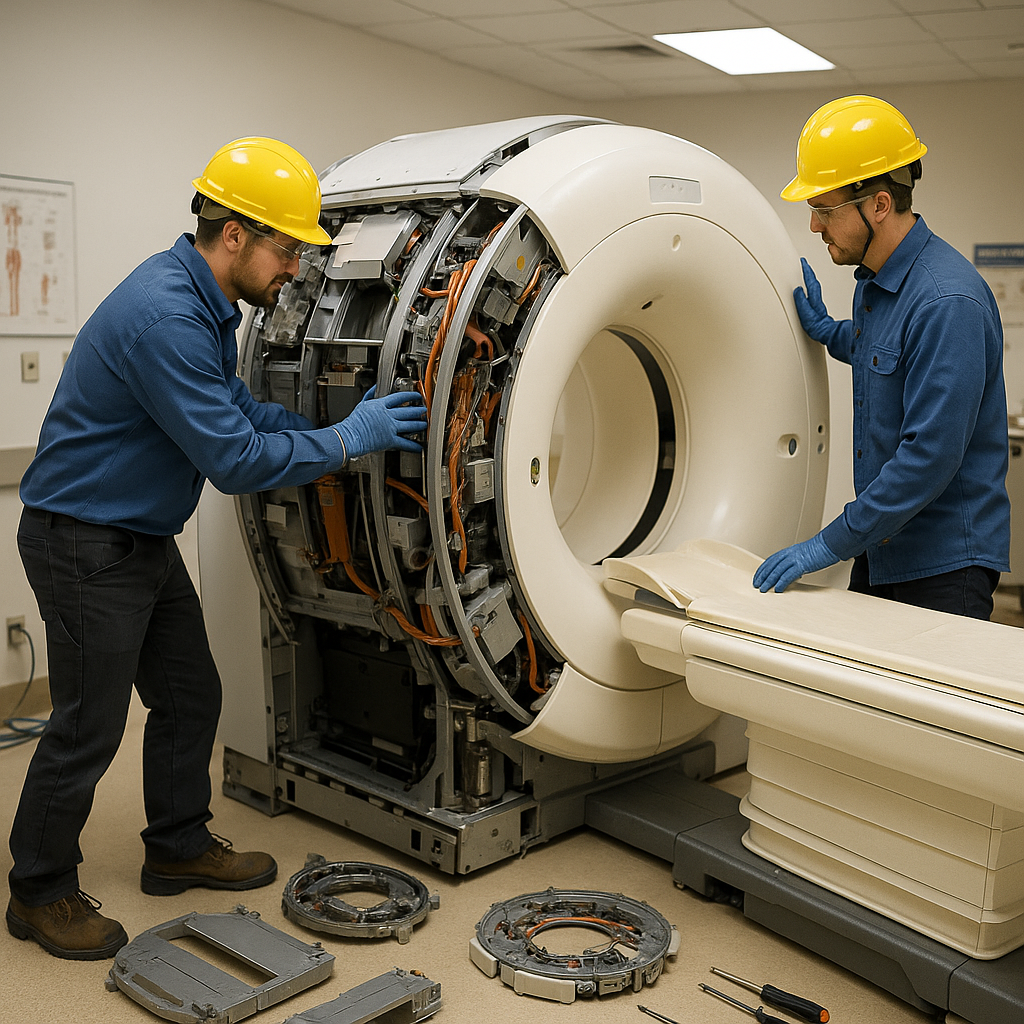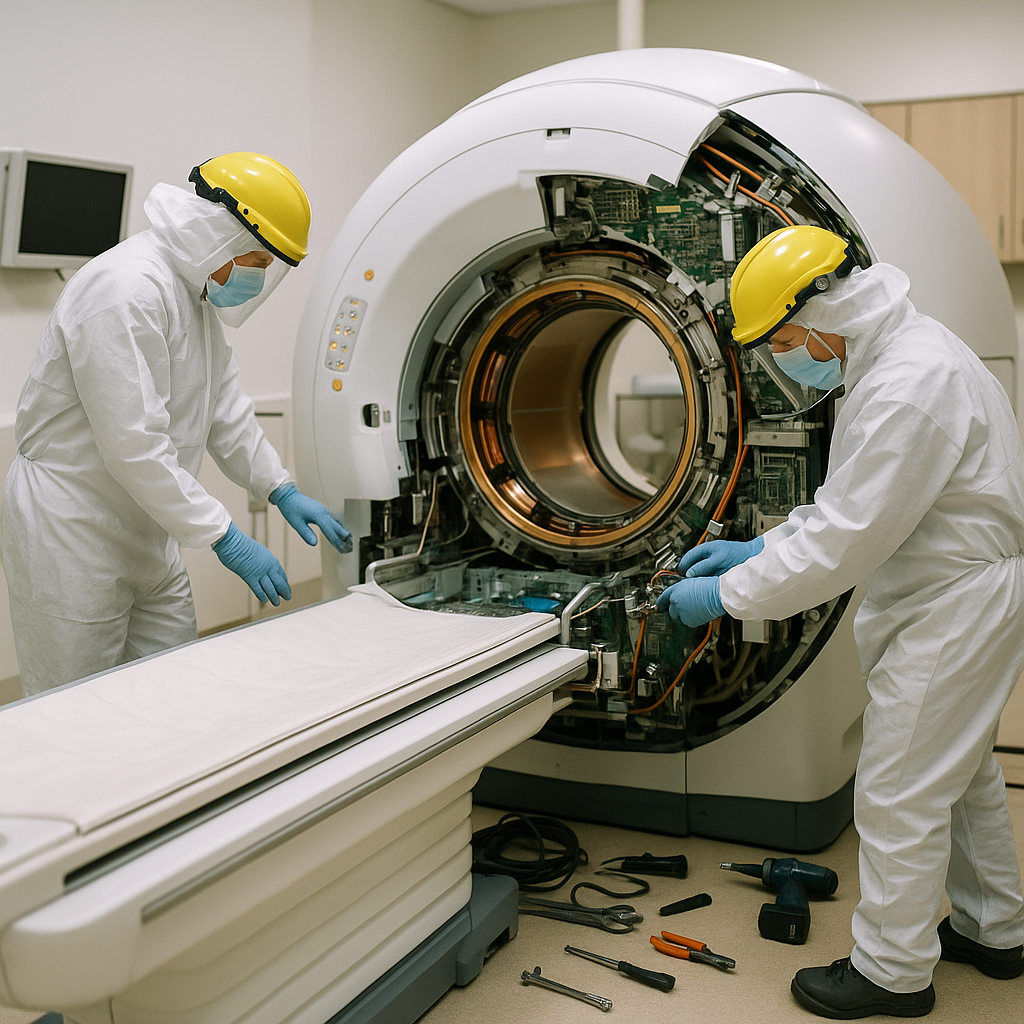5901 Botham Jean Blvd, Dallas, TX 75215
MRI Machine Decommissioning in Dallas: A Process & Risk Management Guide
November 12, 2025Decommissioning an MRI machine is far more complex than unplugging a desktop computer. These advanced medical imaging systems contain powerful superconducting magnets, hazardous materials like liquid helium, and components that pose significant safety risks if not properly handled. The process requires specialized knowledge and strict adherence to safety protocols.
MRI machine decommissioning in Dallas involves a comprehensive, multi-stage approach that extends far beyond simple equipment removal. Professional teams must safely power down magnetic fields, extract valuable materials like copper and niobium-titanium alloys, and manage potentially hazardous substances according to environmental regulations. Each step demands precise execution to protect healthcare workers, patients, and surrounding communities.
Dallas healthcare facilities benefit from having access to experienced decommissioning specialists who understand both the technical complexities and regulatory requirements involved in MRI removal. These experts handle everything from initial system shutdown and hazardous material containment to final transport and environmentally responsible disposal. This professional approach ensures minimal disruption to ongoing medical operations while maximizing the recovery of valuable recyclable materials.
What Does the MRI Decommissioning Process Involve?

MRI decommissioning requires precise coordination among specialized teams and careful adherence to safety protocols. The process involves multiple stages that must be executed sequentially to ensure equipment integrity and workplace safety.
Each phase demands specific expertise and equipment. Engineers conduct initial assessments, while rigging specialists manage heavy components. The logistics team coordinates transportation while ensuring regulatory compliance throughout.
Essential Steps in MRI Decommissioning
The MRI de-installation process follows a systematic approach, addressing specific safety and operational requirements.
- Initial Site Assessment and Inventory: Engineers arrive on-site to inspect the MRI system and document all components. This inventory identifies valuable materials such as niobium-titanium alloy wires and establishes removal priorities based on material value and safety considerations.
- System Powering Down: Technicians follow manufacturer-specific protocols to safely disconnect the MRI from power sources. For superconducting systems, controlled magnetic field ramping is necessary to prevent equipment damage and safety hazards.
- Hazardous Material Removal: Specialized teams extract liquid helium and other cryogens using proper containment systems. This step prevents rapid expansion and pressure buildup that could create dangerous conditions during transport.
- Route Planning and Facility Preparation: Teams evaluate exit routes and measure doorways, windows, and corridors. Site planning includes identifying structural capacities for heavy lifting operations and preparing knockout panels if necessary.
- Component Disassembly: Professional crews systematically break down the MRI into transportable sections. They carefully separate the gantry, patient table, electronics cabinets, and subsystems using appropriate tools and techniques.
- Rigging and Heavy Lifting Operations: Certified rigging specialists use cranes and specialized lifting equipment to move components weighing several tons. Heavy lifting requires precise coordination between crane operators and ground crews.
- Professional Packing and Transport Preparation: Components are given protective wrapping and custom packaging to prevent damage during transport. High-value materials are segregated and documented for tracking purposes.
Safety and Logistics Coordination
Site planning goes beyond route assessment to include facility protection measures. Teams lay protective materials over flooring, walls, and surfaces to prevent damage during component removal.
The logistics team maintains constant communication with facility management throughout the process. This coordination ensures minimal disruption to ongoing operations and addresses any unexpected challenges during decommissioning.
Professional packing standards protect both valuable materials and sensitive components during transport. Proper documentation tracks each component from removal through final disposition, supporting regulatory compliance and material recovery objectives.
What Are Key Considerations for MRI Transport and Disposal?
Transportation Requirements and Cold Storage Systems
MRI machines present unique transportation challenges due to their sensitive superconducting magnets that must remain at extremely low temperatures. These magnets require constant cooling at -269 degrees Celsius (-452 degrees Fahrenheit) to maintain their magnetic field strength. Without proper temperature control, a phenomenon called “quenching” can occur, where the magnet loses its superconductivity and potentially suffers irreversible damage.
Specialized cooling containers are essential for safe MRI transport. These refrigerated containers, also known as reefers, utilize advanced technology to maintain the correct internal temperature throughout the journey. They employ glycol heat exchange systems specifically designed for MRI machine transportation, ensuring the delicate cooling systems remain functional during transit.
Transportation by sea has become increasingly viable with advanced cooling container technology. Although shipping times may be longer than air transport, sea freight offers significant cost savings and reduces environmental impact through lower carbon emissions. This approach allows healthcare facilities to manage MRI relocations more economically while maintaining equipment integrity.
Helium Maintenance and Running Cold Head Technology
The running cold head is a critical component in MRI transport systems. It operates continuously during transportation to minimize helium loss from the superconducting magnet system. The cold head works alongside the MRI’s existing cooling infrastructure to maintain the ultra-low temperatures required for proper magnet function.
Helium management during transport requires careful coordination between the cooling container and the MRI’s internal systems. An attached generator powers both the container’s refrigeration system and the helium compressor, ensuring uninterrupted cooling throughout the journey. This dual-power approach prevents magnetic field degradation and reduces the risk of costly quenching incidents.
Professional technicians must monitor helium levels and system performance throughout the transportation process. Remote monitoring devices track shipping conditions and immediately notify relevant parties when issues arise. This real-time oversight ensures any problems can be addressed quickly to protect the valuable equipment.
Environmental and Safety Compliance for Disposal
MRI disposal involves navigating complex environmental regulations due to the hazardous materials within these machines. The powerful magnets use rare earth elements and superconducting materials posing environmental hazards if mishandled. Additionally, cryogenic cooling systems often contain helium that must be safely recaptured rather than released into the atmosphere.
Healthcare facilities must comply with both federal and state environmental regulations. The EPA maintains strict guidelines for hazardous waste disposal, with penalties reaching up to $70,117 per day for violations. MRI machines also contain trace amounts of mercury, beryllium, and other toxic metals requiring specialized handling procedures.
Data security is another crucial compliance requirement during MRI disposal. Healthcare providers must ensure patient information protection throughout the decommissioning process. HIPAA regulations mandate thorough data sanitization using DOD-level wiping software before any equipment leaves the facility.
Professional Handling Standards
Specialized MRI decommissioning services provide the technical expertise necessary for safe equipment retirement. These professionals understand both the complex engineering requirements and regulatory compliance standards. They handle everything from data destruction to cryogen recovery while providing auditable records of the entire process.
The disposal process begins with proper decommissioning procedures that safely power down the system and remove hazardous materials like cryogens. Trained technicians then disassemble the machine using appropriate lifting equipment and custom restraints to prevent damage during handling. Humidity control remains critical throughout this process to protect electronic components.
Resource recovery is a valuable aspect of professional MRI disposal. The superconducting magnet contains niobium-titanium alloy wires embedded in copper, with the alloy selling for $10 to $15 per pound. Advanced separation technologies like Mag-Xtract and hydrometallurgy can isolate these valuable materials for reintegration into new high-tech devices, offsetting disposal costs while supporting sustainable practices.
Why Is Professional MRI Decommissioning Important?

Safety Requirements and Risk Management
MRI machines present significant safety hazards requiring specialized handling during decommissioning. These powerful imaging systems generate magnetic fields thousands of times stronger than Earth’s magnetic field, creating constant projectile risks for ferromagnetic objects. Professional decommissioning teams are aware of these dangers and adhere to strict safety protocols to protect healthcare staff and facility operations.
The decommissioning process involves multiple critical steps that untrained personnel cannot safely execute. Disconnecting power supplies, discharging superconducting magnets, and safely removing liquid helium require specialized equipment and expertise. Proper magnet discharge procedures prevent accidental activation and eliminate residual magnetic fields that could pose ongoing safety risks.
Healthcare facilities face significant liability exposure when attempting DIY decommissioning. Professional services carry appropriate insurance coverage and follow manufacturer guidelines to minimize accident risks. This protection extends beyond the decommissioning process to include proper site remediation and safety verification.
Regulatory Compliance and Environmental Standards
Healthcare organizations must navigate complex regulatory requirements during MRI disposal. HIPAA regulations mandate secure destruction of any patient data stored within the system’s computer components. Professional decommissioning services use DOD-level data wiping software and provide auditable documentation to ensure compliance with privacy regulations.
Environmental regulations add another layer of complexity to MRI disposal. These machines contain hazardous materials, including mercury, beryllium, and other toxic metals that require specialized handling. EPA regulations classify many components as hazardous waste, with violations carrying penalties up to $70,117 per day.
Professional services understand these regulatory frameworks and maintain proper certifications for hazardous material handling. They coordinate with regulatory agencies when required and provide comprehensive documentation proving compliant disposal methods. This reduces healthcare facilities’ regulatory risk while ensuring environmental protection standards are met.
Space Optimization and Facility Upgrades
Professional decommissioning services optimize the removal process to minimize facility disruption. MRI machines typically weigh several tons and require specialized rigging equipment for safe removal. Experienced teams coordinate with facility management to protect building infrastructure during the extraction process.
The decommissioning timeline directly impacts a facility’s ability to install new diagnostic equipment. Professional services work efficiently to complete removal within agreed timeframes, allowing seamless transitions to advanced imaging systems. This coordination prevents extended downtime that could disrupt patient care and revenue generation.
Proper space preparation for new equipment installation begins during the decommissioning phase. Professional teams assess structural requirements, electrical systems, and ventilation needs for upgraded technology. This advance planning ensures facilities can maximize their diagnostic capabilities without additional delays or unexpected costs.
Cost Management and Value Recovery
Professional decommissioning services often provide cost-neutral solutions through materials recovery programs. MRI machines contain valuable components, including copper wiring, aluminum structures, and rare earth magnets. The niobium-titanium alloys in superconducting magnets alone can sell for $10 to $15 per pound, helping offset decommissioning costs.
Healthcare facilities attempting self-decommissioning often face unexpected expenses from equipment damage, safety violations, or regulatory fines. Professional services provide upfront cost estimates and guarantee completion within budget parameters. This predictable pricing model helps facilities plan capital expenditures for equipment upgrades.
Insurance considerations also favor professional decommissioning services. Most healthcare facility insurance policies require proper disposal methods for complex medical equipment. Using certified professionals helps maintain coverage and prevents potential claim denials related to improper disposal practices.
Conclusion
As outlined, retiring an MRI machine is a high-stakes operation fraught with technical, safety, and regulatory challenges. From managing supercooled magnets and hazardous cryogens to ensuring full HIPAA and EPA compliance, the risks of improper handling are significant.
Entrusting this complex task to certified professionals is not just a best practice—it is essential for protecting personnel, securing patient data, and ensuring environmental responsibility. This professional approach also maximizes the recovery of valuable materials, turning a complex liability into a manageable, and often cost-neutral, process.
To ensure your MRI machine retirement is handled safely and responsibly, contact Okon Recycling at 214-717-4083 for their recycling needs.
